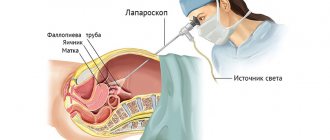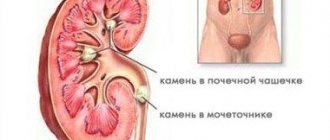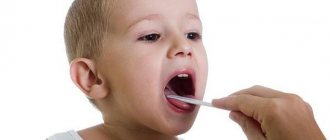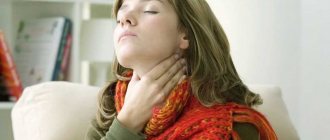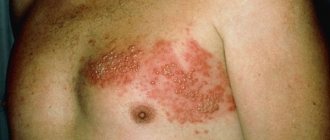Shereshevsky-Turner syndrome
(Turner syndrome, Ullrich syndrome) is a typical form of dysgenesis (underdevelopment) or primary agenesis (complete underdevelopment) of the female gonads - the ovaries, caused by genetic deformation and accompanied by short stature and a number of developmental anomalies of the body and some internal organs. The clinical picture of this syndrome was described in the 20s of the twentieth century by endocrinologist N.A. Shereshevsky. This syndrome develops only in females.
Shereshevsky-Turner syndrome is a chromosomal disorder
, which is characterized by either the complete absence of one chromosome or the presence of a defect in one of the X chromosomes. The karyotype of such women is 45 X0, or the mosaic type is 45 X/ 46 XX, 45 X/ 46 XY. According to medical statistics, Shereshevsky-Turner syndrome occurs in one case per 4000 live births of girls, despite the fact that 98-99% of pregnancies with fetal karyotype 45 X0 result in spontaneous abortions in the early stages, therefore this pathology is classified as one of the most common chromosomal anomalies among women.
Causes of development of Shereshevsky-Turner syndrome
In half of the patients with Shereshevsky-Turner syndrome, the complete absence of one of the chromosomes is detected, and karyotyping determines the corresponding 45 X karyotype. Moreover, in 70-80% of cases the father's X chromosome is absent. In the other half of the patients, a mosaic type karyotype is detected, in which one X chromosome is normal and one is ring (consisting of preserved sections of the short and long chromosome arms). In a number of patients, one regular X chromosome is found in the karyotype, and the other is an isochromosome, which loses the short arm and consists of two long arms of the X chromosome. Depending on what karyotype the patient has, the external manifestations of the syndrome vary from typical signs, according to the clinical picture of the disease, to their complete absence.
As a result of the absence or deformation of the sex chromosome in girls, the process of ovarian maturation is disrupted, there is a delay or complete absence of puberty and, as a consequence, the development of infertility. The chromosomal imbalance observed in Shereshevsky-Turner syndrome also leads to various anomalies of somatic development (body development).
Medical curiosity
There are two other diseases that are sometimes abbreviated as Turner syndromes. These pathologies were discovered and described by the namesakes of the American endocrinologist Henry Turner, hence the confusion with the names. These are May-Turner and Personage-Turner syndromes. Both of these diseases are in no way related to the monosomy on the X chromosome described above, and are not even hereditary diseases.
The first description of May-Turner syndrome appeared in 1957. The pathology is manifested by a violation of the outflow of venous blood from the left lower limb and pelvic organs, as a result of which patients suffer from constant pain in the left leg and pelvic area. In the later stages of the disease, deep vein thrombosis is visible on venography. The syndrome is difficult to diagnose, especially in the early stages, as it is initially asymptomatic. May-Turner syndrome usually begins in adolescence and is more common in men than women.
Ultrasound of the iliac veins of the pelvis is used as the main diagnostic procedure. If the disease is present, the left common iliac vein is significantly larger in diameter than normal. To confirm the diagnosis, magnetic resonance angiography of the iliac veins with contrast is used. In the later stages of the disease, treatment is performed surgically. Medications are often prescribed to restore normal blood flow.
Personage-Turner syndrome is rare in clinical practice and its causes have not yet been precisely established. The first signal about the presence of the disease is a sharp, causeless pain in the shoulder or arm, less often in both arms at the same time. Many people who first developed this pathology do not consider it necessary to seek help from a specialist, hoping that the symptoms will disappear on their own.
The pain may not go away for several days, sometimes for several weeks. The pain increases with movement and decreases if the limb is at rest. Many patients stop developing their arm, which is why muscular dystrophy develops over time. For most people, the disease resolves over time without any intervention. Sometimes strong analgesics are required. The causes of Personage-Turner syndrome are of great interest to doctors, but have not yet been studied. The prevalence of the disease is also unknown.
Shereshevsky-Turner syndrome - signs of the disease
Patients with Shereshevsky-Turner syndrome complain of lack of menstrual flow, short stature and some cosmetic defects in appearance.
Most newborn girls with this disease have only mild clinical manifestations, but a certain group of infants have lymphedema of the hands and feet, as well as skin folds on the back of the neck. Some of the most common anomalies found in Shereshevsky-Turner disease are a short neck with low hair growth and wing-shaped cervical folds, an expanded chest, poorly developed genitals - the labia minora, clitoris, uterus, as well as widely spaced inverted nipples. Some patients have abnormalities in the shape and location of the ears (protruding ears), which are combined in half of the cases with hearing loss.
Compared to their relatives, girls are shorter - no more than 150 cm, but at the same time their body weight is quite impressive. Less commonly, signs such as multiple pigmented nevi or vitiligo, anomalies of the metacarpal and metatarsal bones of the hands and feet, deformation of the elbow and shoulder joints, and hypoplastic narrow nails are detected. The facial part of the patients is also modified - the jaw bones are reduced in size, the palate is high, and drooping eyelids are also observed.
From the internal organs, it is possible to detect cardiac anomalies in the form of coarctation of the aorta, its dissection, disruption of the integrity of the interventricular septum and bicuspid aortic valve. Congenital anomalies and malformations of the kidneys (horseshoe kidney, duplication of the pelvis and ureters), and blood vessels of a tumor nature (hemangiomas, telangiectasia) are also common.
The female gonads are replaced by strands of connective tissue that are unable to produce germ cells, as a result of which the vast majority (90%) of sick girls do not go through puberty, the mammary glands do not enlarge, and primary amenorrhea develops. In the remaining 10%, the spontaneous onset of menstruation is possible, but even in this case, the woman’s fertility remains in question.
The mental sphere of patients with Shereshevsky-Turner syndrome practically does not suffer. True, some authors note a decrease in their attention and some processes of perception, in particular spatial, which affects the quality of processing of nonverbal (nonverbal) information.
There are three forms of gonadal dysgenesis - erased, pure and mixed, which differ from each other in clinical manifestations. When the form is erased
In patients, a mosaic karyotype of 45 X0/46 XX is detected, and the severity of the clinical picture is associated with the ratio of cells with a normal and deformed karyotype. If the percentage of cells with the absence of one of the X chromosomes predominates, then the external signs of the patient will be similar to the classic appearance of patients with Shereshevsky-Turner disease. Otherwise, spontaneous development of external sexual characteristics will be noted, but patients will have primary amenorrhea and signs of underdevelopment of the genital organs.
Pure form of ovarian dysgenesis (Swyer syndrome)
characterized by karyotype 46 XX or 46 XY. It is difficult to recognize the presence of chromosomal defects by appearance, since the growth of patients is normal, somatic defects and anomalies are not detected. However, external sexual characteristics are poorly developed. In addition, upon examination, genital infantilism is revealed, i.e. the genitals are also underdeveloped.
Mixed form of ovarian dysgenesis
manifested by primary amenorrhea, virilization - enlargement of the clitoris, male-type hair growth, which is due to the presence of an inferior Y-chromosome in the karyotype. With this form of the disease in the postpubertal period, combined type ovarian tumors are possible - gonadoblastomas, embryonal carcinomas.
Diagnostic features at birth
Many studies have proven that a significant proportion of cases of Shereshevsky-Turner syndrome lead to spontaneous termination of pregnancy. For this reason, the frequency of newborns with this syndrome is much lower than with Klinefelter syndrome. A newborn has a number of external signs that allow visual diagnosis of the disease already in the maternity hospital:
- Born girls are physically behind normal values. Thus, the body length of newborn girls rarely exceeds the threshold of 40 cm, and the body weight is 2200 g.
- The excess skin on the neck of a newborn girl in the form of a characteristic fold is striking. It is clearly detected in more than 70% of children, and in the rest it can be moderately developed.
- The lower border of hair growth is often greatly reduced and often extends to the back, visually shortening the already short neck.
- Even in childhood, the child’s growth rate is reduced, and quite early they begin to clearly lag behind their peers.
- Disproportional build with a short torso and broad chest.
- Multiple anomalies of the development of the bone skeleton with severe deformations of many joints, the spinal column, ribs, sternum, upper and lower extremities, deformations of the facial skull and large joints of the extremities.
- A characteristic symptom is lymphostasis or congestive swelling of the feet and often the hands due to abnormalities in the development of lymphatic capillaries.
- Anomalies in the development of the ears complement the diagnostic signs of the disease - the ears are deformed, protruding and set much lower than in healthy babies
Diagnosis of Shereshevsky–Turner syndrome
General diagnostic criteria for all forms of Shereshevsky-Turner syndrome are height less than 150 cm, primary amenorrhea, underdevelopment of the genital organs, absence or poor development of secondary sexual characteristics, according to ultrasound examination - a reduced uterus with a linear endometrium, and ovaries without follicles. Blood tests reveal elevated levels of gonadotropins, particularly follicle-stimulating hormone, and decreased levels of estrogen. Karyotyping allows you to identify a defective set of chromosomes, with the absence or significant reduction of sex chromatin.
Differential diagnosis of Shereshevsky-Turner syndrome is carried out with primary amenorrhea of hypothalamic origin. Unlike the latter, patients with Shereshevsky-Turner syndrome do not have neuropsychiatric symptoms.
Prenatal diagnosis
It's no secret that modern diagnostic methods make it possible to identify most genetic abnormalities of the fetus long before birth. One such procedure, non-invasive prenatal testing (screening for cell-free fetal DNA in the mother's blood), can be performed from the end of the first trimester of pregnancy.
The advantage of this procedure is that it is completely harmless to the mother and fetus. In addition to Turner syndrome, cell-free DNA screening can detect aneuploidies such as Patau syndrome (trisomy 13), Edwards syndrome (trisomy 18), Down syndrome (trisomy 21), trisomy X , Klinefelter syndrome, Martin-Bell syndrome.
Ultrasound examination can identify abnormalities in the development of the kidneys and heart - these are possible symptoms of the disease.
The syndrome can be detected using amniocentesis or chorionic villus sampling. Both of these procedures are invasive and have contraindications. Their advantages include the high accuracy of the results obtained.
Treatment of Shereshevsky–Turner syndrome
The choice of treatment tactics for patients with Shereshevsky-Turner syndrome depends on the presence or absence of the Y chromosome in the karyotype. If elements of the Y chromosome are detected in the karyotype, the ovaries are surgically removed at a young age (up to 20 years), in order to prevent the degeneration of the gland tissue into a malignant tumor.
In cases where there is no Y chromosome in the karyotype of patients, or after surgical removal of the ovaries, hormone replacement therapy with estrogen is prescribed at the age of 16-18 years, the purpose of which is the development of secondary sexual characteristics (female hair growth, enlarged mammary glands), reducing the level of gonadotropins, restoring menstrual cycle, preventing the development of estrogen deficiency conditions - osteoporosis, metabolic disorders, diseases of the cardiovascular system, improving the quality of life and adaptability to society. If necessary, patients are provided with psychological assistance.
Short stature is corrected by administering growth hormone until the growth plates are closed. The prognosis of Shereshevsky-Turner syndrome is favorable in terms of life expectancy and intellectual development. With regard to restoration of reproductive function, the prognosis is unfavorable; most patients remain infertile.
Lymphedema
In the photo, lymphedema - due to a violation of the outflow of lymph and its accumulation in the intercellular space, the volume of the limbs increases.
Lymphedema is a disease in which swelling of a part of the body appears, which occurs due to improper functioning of the lymphatic system (see photo of lymphedema).
Lymphedema is a chronic pathology of the lymphatic system, leading to other diseases such as ulcers, increased pigmentation, eczema, thickening, etc.
Paronychia
Paronychia is a purulent inflammation of the periungual fold and tissues at the base and sides of the nail.
The disease may be caused by Shereshevsky-Turner syndrome. Another cause of paronychia is infection under the skin as a result of injury, prolonged exposure to chemicals, or poor personal hygiene.


